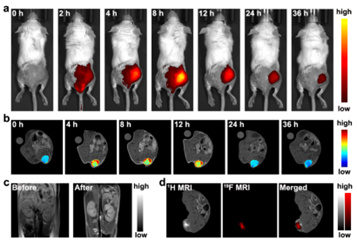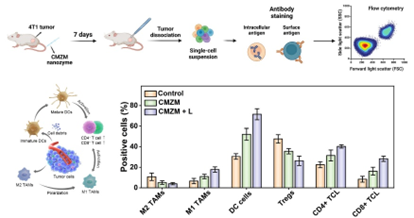

Ultrasensitive Magnetic Resonance Research Group developed a H-1/F-19 dual-nuclei MRI probe to guide tumor immunotherapy
Recently, the Ultrasensitive Magnetic Resonance Research Group developed a nanoprobe with multiple nanozyme activities to achieve 1H/19F dual nuclei MR/FL multimodal precise detection of 4T1 tumors. Through multiple nanoenzyme cascade reactions, the immunotherapy efficiency of 4T1 tumors can be enhanced by activating the immune response in the tumor region via improved ROS production. The research was published in the Journal of Advanced Materials.
Early detection and treatment of tumors play a crucial role in their prognosis. With the development of molecular imaging and tumor therapeutics, an integrated diagnosis and treatment technology has emerged. The integrated diagnosis and treatment technology not only enables early detection of tumors but also monitors the delivery of therapeutic agents to the tumor region in real-time, thus achieving integration of diagnosis and treatment. 19F MRI has no background signal interference and high contrast, which can be used to complement 1H MRI in clinical research. Based on the above reasons, we designed a tumor microenvironment-responsive 1H/19F dual-nuclei MRI probe with the ability of tumor targeting and excellent anti-tumor therapeutic effect.

In vivo FL/1H/19F dual-nuclei multimodal imaging of CMZM.
In addition, the probe can be used as a cascade-enhanced nanoenzyme immunomodulator (CMZM) with a variety of enzyme activities including superoxide dismutase (SOD), catalase (CAT), peroxidase (POD) and glutathione oxidase (GSHOx), reversing the tumor immunosuppressive microenvironment. In virtue of the acidic/GSH responsive collapse of CMZM, the chemodynamic therapy and photodynamic therapy enhanced immunotherapy of tumors can be obtained under the guidance of 1H/19F dual-nuclei MRI.
Remarkably, a new protocol based on 19F NMR was developed to determine the peroxidase (POD)-like and glutathione oxidase (GSHOx)-like activities of CMZM. Compared with traditional optical methods, 19F NMR technology with unlimited tissue penetration depth has great potential in the determination of multifunctional enzyme-like activities of nanozymes in vivo. Thanks to the multienzyme-like activities of CMZM, the immunosuppressive tumor microenvironment can be reversed by relieving tumor hypoxia, facilitating the polarization of M2 macrophages to the M1 phenotype. Further, the exposure of tumor-associated antigens (TAAs) caused by sufficient ROS production elevated the antitumor efficiency by accelerating dendritic cell maturation and the infiltration of CTLs into the tumor. Ultimately, the introduction of α-PD-L1 results in the complete inhibition of both primary and distant tumors. Consequently, this approach holds significant promise for potential future clinical applications.

The immune related cell analysis of tumor after treatment with CMZM.
The research was titled "Augmenting Immunotherapy via Bioinspired MOF-based Ros Homeostasis Disruptor with Nanozyme-Cascade Reaction" and published in the Journal of Advanced Materials. Innovation Academy for Precision Measurement Science and Technology was the first unit to complete this work. Ruifang Wang, Maosong Qiu, and Professor Lei Zhang were co-first authors, and Professor Shizhen Chen and Professor Xin Zhou were corresponding authors.
Paper Link:https://onlinelibrary.wiley.com/doi/10.1002/adma.202306748

Innovation Academy for Precision Measurement Science and Technology, CAS.
West No.30 Xiao Hong Shan, Wuhan 430071 China
Tel:+86-27-8719-8631 Fax:+86-27-8719-9291
Email:hanyeqing@wipm.ac.cn
鄂ICP备15017570号-1